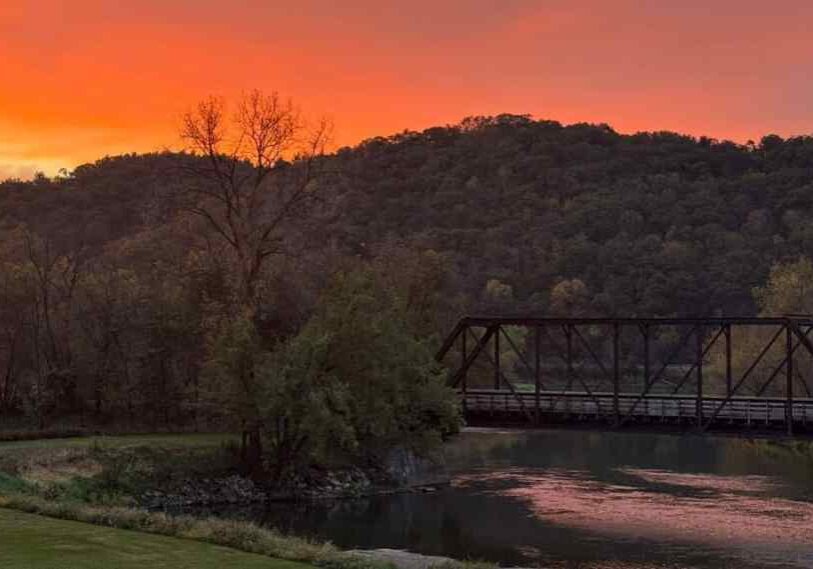Essay | Haunted by Time: Southeastern Minnesota’s Forgotten Schoolhouses and Farmsteads
Local relics that still whisper of history, hard work and community

SUMNER TOWNSHIP, FILLMORE COUNTY — So there I was, driving down Fillmore County 4, trout, trout and trout on my mind when I saw an old car in the weeds. And another. And then what appeared to be an abandoned schoolhouse.
I had to stop to admire that old building with its now-empty bell tower, a half-circle window above the door and a small section of roof caved in.
I love those beat-up, falling-down, time-haunted buildings, ones I’ve seen as I’ve driven the back roads of the region for nearly 50 years. They are perfect for this time of year when spooks, goblins and ghosts are said to be haunting old buildings around Halloween.

Hidden away in the northwest corner of Fillmore County, the old Washington Schoolhouse has been abandoned for many decades. (Photo by John Weiss)
But they are also perfect year-round because they are haunted indeed — but by memories, their past and their lessons for the future.
I can imagine students running to school, maybe driven there in a horse-drawn wagon, maybe on horseback and, of course, walking through blizzards, uphill both ways.
How many students went there? Surely most stayed in the area, probably farmed.

Historic photo of Sumner Township’s Washington Schoolhouse. (Photo courtesy of the Fillmore County History Center)
But did some, because of the lessons learned in that school, fly to universities where they learned to help the county, state or world?
How many students dreaded the painfully long hours, how many rejoiced to learn as hours flowed fast? And who drove those old cars?
Such buildings are often safety hazards, so they are bulldozed, or maybe time or heavy snow flattens them. But I hope more of them can be left standing as a hallowed history lesson, a true treat to let slowly sag into the earth.
These old schools continue to teach lessons just by standing and aging.
Yes, there is a certain melancholy sadness to them but maybe that’s part of their charm. And maybe they are vivid reminders of our future.
We are a culture obsessed by the new, with never aging. But look at such buildings, remember they were once new but now are weathered and time sagged. That will happen to all our buildings, maybe in decades, maybe centuries.
Curious, I looked at an equally old history book at the Fillmore County History Center in nearby Fountain. It had a lot more on the history, not just of the school, but the area.
Still, it was the school on my mind. There was a picture of the school maybe a century ago, no old cars, no brush and trees crowding it. I’m sure I could see the bell.

Another abandoned schoolhouse along the author’s journey through the Root River Valley, this one near Rushford. (Photo by John Weiss)
If only these buildings could talk, the stories they’d tell
Like so many settlements in the region, the first European pioneers (Native Americans were here millennia before) came in 1853 and the area was soon a thriving area. More than 100 young men would volunteer for fighting in the Civil War.
In its prime, Washington had the usual assortment of stores, a butcher, two blacksmiths, a church, school, post office and 10 homes; the hamlet served the surrounding farms.
The first true school building stood until 1906 when an overturned stove burned it down. The new one was soon up and also served as a local church.
The history also says students will be students, no matter how long ago. It states one teacher quit after a few months “because she could not handle the pupils.” Another teacher “kept strict order.”
In 1942, there was again a fire, but the school was rebuilt.
In 1959, Washington consolidated with larger schools and the building was sold to the American Union Sunday School Association. When it was abandoned, I don’t know. We can’t see any of that rich history in Washington’s school.
As I drove farther down the county road, I almost missed an old, toppling house because it was nearly hidden by trees.

This nearly collapsed house is also located on Fillmore County Road 4. (Photo by John Weiss)
When I stopped and looked closely, I could see it — and it made me wonder how many families had lived there, how many children were born there, how many meals served in the kitchen, how many joys, how many sorrows were lived out there, do any people still living have memories of being raised there?
I’m glad it’s there to tell us not to get too cocky about what we have today.
One of my favorite old homes is along U.S. 61 near Kellogg. It was a third of a mile off the highway and had fallen backward halfway.
The two glassless windows looked like eyes watching the heavens. The last time I drove past, it was down, knocked down by time or humans. But I have the memories.
Another was the really old shell of a limestone-walled building I saw at the ground-breaking for the new Chatfield Elementary School on the bluff overlooking the town; the school opened in 2009.
What a great education tool, I thought. Maybe make sure it’s safe and bring students there to learn about history of the area, why it has limestone walls. They could use it for art or writing.
When I looked recently, I didn’t remember exactly where it was. When I drove around, I found it’s either hidden by new homes or it’s been knocked down.

Driving east from Chatfield toward Rushford, the old General Store stands in Pilot Mound. (Photo by John Weiss)
I think maybe those old buildings are a message to me.
I recently turned 75 and my time will come when I will be forced to slow down more, maybe sag, be no longer useful in the usual ways.
Will I be useful to my children and grandchildren, maybe a way for them to learn their history?
Will I be a good lesson to children and grandchildren about how life is a cycle, how we all fade away?

The Rushford area schoolhouse bell is long gone; the roof is caving in. (Photo by John Weiss)
Maybe the best adage I could think of for the old buildings is the famous Latin phrase:
Sic transit gloria mundi (thus passes the glory of the world).





